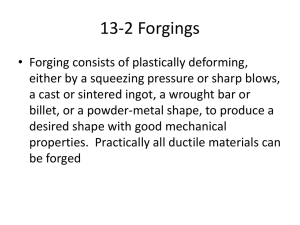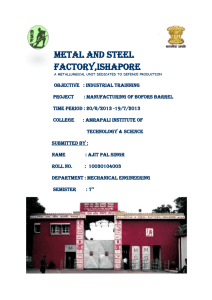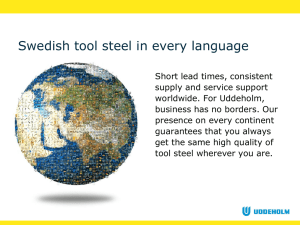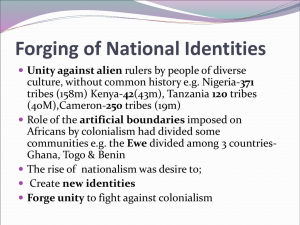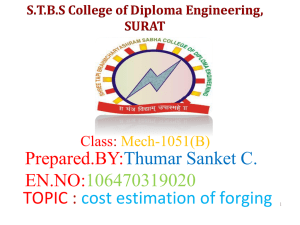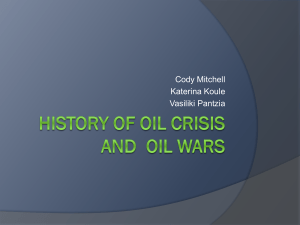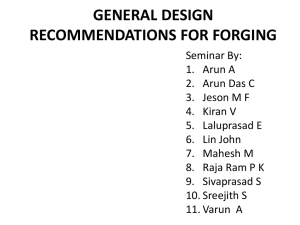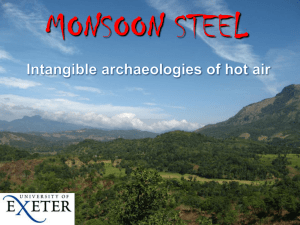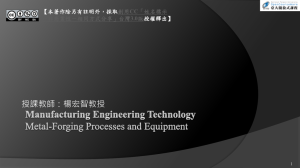File - Vigyan Pariyojana
advertisement
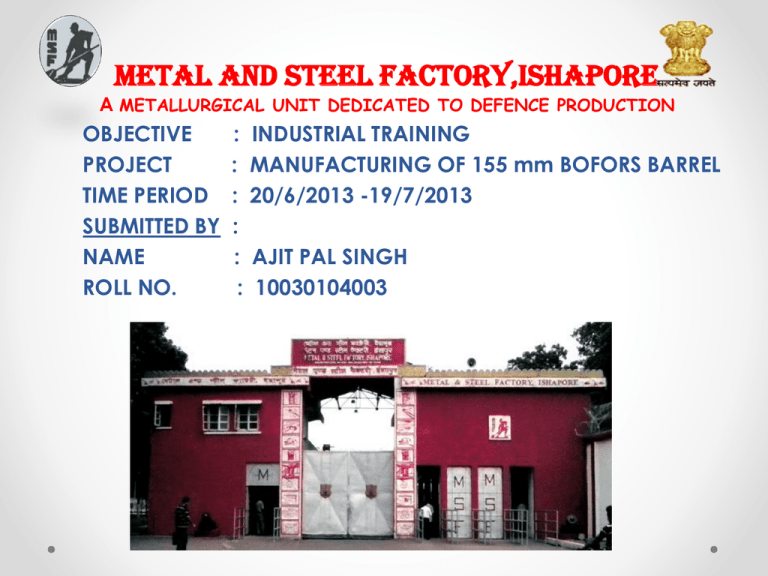
METAL AND STEEL FACTORY,ISHAPORE A METALLURGICAL UNIT DEDICATED TO DEFENCE PRODUCTION OBJECTIVE PROJECT TIME PERIOD SUBMITTED BY NAME ROLL NO. : : : : : : INDUSTRIAL TRAINING MANUFACTURING OF 155 mm BOFORS BARREL 20/6/2013 -19/7/2013 AJIT PAL SINGH 10030104003 FACTORY PROFILE: Metal & Steel Factory Ishapore, under Ordnance Factory Board, Ministry of Defence, Government of India, is main producer of basic Ferrous and Non-Ferrous raw material for military Hardwar. MSF has facilities for steel making in the form of Electric Arc Furnace, Ladle Furnace Vacuum Degassing & Electro steel Re-melting ensuring production of ultra clean steel. A high capacity PLC controlled 2650 T Forging Press with fully integrate an double manipulators gives shape to the products like gun-barrel & other components of artillery and tank guns. A CNC controlled Radial Forging Press of 1250T for each hammer can forge various section and profiles with degree of mechanical properties. The factory possesses a hot rolling mill, a high precision combination cold rolling mill for making the thin strips of ferrous and non-ferrous material with online X-ray and mechanical gauging system. Precision controlled heat treatment facilities impart high mechanical properties in the metal, making it capable of performance under conditions of high stress. Quality intelligence personnel with sophisticated machinery consisting of Ultrasonography, Chemical Testing, Computer aided Spectrographic, Hydrogen Gas Analyser and 3D coordinator for precision dimensional measurement etc. LOCATION Metal &Steel Factory, Ishapore is situated in West Bengal on the eastern bank of river Hoogly(Ganga) at a distance of 28 Km from Netaji Subhash Chandra Bose airport, Dumdum. HISTORICAL BACKGROUND The factory has its origin as a part of Gun & Shell Factory at Cassiporethen known as Foundary & Shell Factory in year 1872. In year 1892, manufacturing of steel was taken up when open-heart furnace was comissioned. In year 1905, it was relocated at Ishapore and continued to function as a part of Gun & Shell Factory, Cassipore. In 1920, it became an indipendent unit in the family of Ordanance Factories and had to be known as Metal and Steel Factory, Ishapore. PRODUCTS OF MSF, ISHAPORE : 25 mm 20 mm AMR 23mm Schilka Cartridge Case Ballistic Cap Barrel Brass Rod Breech Block Pinaka Tube Steel Cone Strip Railway Axel PROJECT NAME : 155mm BOFORS BARREL CAUSE FOR CHOSING THIS PROJECT: METAL AND STEEL FACTORY (MSF) ISHAPUR consists of two major division ferrous and non ferrous. Bofors barrel is one of the main product of this factory which consists all the section or shop in MSF even the new added RFS (Radial forging shop). As it and its test specimen cover almost 80% of the ferrous division so I got opportunity to know all major section briefly, which increases my practical knowledge in various field. WHAT IS 155mm BOFORS FH (Field Howitzer ? The Bofors FH 77 is still one of the world’s most revolutionary towed field artillery systems. It has an onmount axillary power unit (APU) that gives the system its self-propelled capabilities and supplies power to the hydraulically supported operations, making it easy to handle. It also has the unique advantage of having a fully integrated land navigation system that gives the coordinates of o the gun position and automatic alignment of barrel. DRAWING OF BOFORS BARREL STEEL MELTING SHOP INPUT: Scrap iron, iron ore, lime, coke/carbon and other element(S, P, Mo, Si etc.) WORKING PROCESS: The electrodes are highly charged and scrap iron behave as a neutral. As a result of that electrode are produced spark(a flash of light produced due to high potential difference.) For it heat is generated and reach 1550c and scrap iron melt down gradually. After melting the material lime are added To make slag. To generate heat. • The first sample is sent to the spectrographic test to know chemical composition present in it. • From the report it is decided, which elements are required to transfer the scrap iron high grade steel like Mn , Si, Mo and Cr etc. • As per need the petroleum, coke or carbon are added to increase the ‘c%’ of the steel. • .The first slag out • After that the melting material are poured to the ladle called teeming. • The ladle is transferred to the LADLE REFINING FURNACE for re melting and achieves 1700 c. • From this step it is transferred to the VACUUM DEGASSING PLANT. By this process H2 and other oxide gas or gas are removed from melting metal. The concept of degassing started primarily to control the hydrogen content in steel. • After finishing vacuum process, the purifying molten metal is poured to the mould. OUTPUT: Ingot for bofors barrel 380-460mm dia. & 2m length. NOTE : In SMS the furnace used is EAF i.e. Electric Arc Furnace that has a capacity of 15 ton. WORKING FUNCTION OF ESR FURNACE: In ESR (Electrode slag re melting) shop the Furnace name is Resistive Furnace, by the name we can make an idea about it the Furnace where heat is generate due to the present of resistance. • This Furnace follow the formula H=I2RT. • Where heat generate with the help of current, which is flow through the electrode and slag. • Slag act as resistance. FORGING OPERATION INTRODUCTION: Forging is a manufacturing process involving the shaping of metal using localized compressive forces. It is the process by which metal is shaped by plastic deformation by suitably applying compressive force. Usually the compressive force is in the form of hammer blows using a power hammer or a press. NECESSITY OF FORGING:Forging of material serves two important purposes. • Improves mechanical properties: Forging can produce a piece that is stronger than an equivalent cast or machined part. As the metal is shaped during the forging process, its internal gain deforms to follow the general shape of the part. As a result, the gain is continuous throughout the part, giving rise to a piece with improved strength characteristics. • Forming the shape: Forging is a type of forming operation. It gives the metal initial formation that will be further machined to get the desired formation. FORGING AT MSF,ISHAPORE Hot forging of 155mm BOFORS gun barrel is done in two forging workshops in Metal & Steel Factory, Ishapore. • RFS(Radial Forging Shop) • NGF(New Gun Forge) RADIAL FORGING SHOP (an ultra-modern forging shop of this factory) RAW MATERIAL : ESR slag produced from methane having diameter 680-700mm is the end length 3m almost. Maximum weight 7.05 ton. PROCESS: Here two types of forging is done they are hollow forging and radial forging. SOLID FORGING: • The job remains solid throughout the cross-section. • After discharging from the furnace the material is immediately taken to the forging machine. HOLLOW FORGING: The most exclusive operation of radial forging machine is to be capable of making hollow forging. • In case of hollow forging a mandle is attached in the boring space which is fitted in the hammering region. • It gives the hollow job enough support to withstand the hammering pressure.The uniformity of the boring diameter is maintained by this process. • The bloom is forged from temperature 110-950C to soften the metal. • The mandle which is fitted in the boring region is not made to face such a high temperature. To avoid this problem the inner surface of the mandle is water cooled reducing the temperature heat about 40C • The core region being most hot, it may attach with the mandle, so if the job is now rotated by manipulator, there may happen twisting effects. As the mandle is cooled, the inner surface shrinks reducing the chance of twisting. PRODUCT: Forged barrel (length is7500mm , dia. 430 ending size, 365 initial size) Why is it termed Radial Forging? The word ‘radial’ comes from the word ‘radius’. After completion of forging operation it can transfer a square bloom into a uniform cylindrical shape. This forging process also supports hollow forging, so it is called Radial Forging. NGF (NEW GUN FORGED) SHOP INPUT : Ingot or ESR slag PROCESS : • At first the raw material that is ingot or slag has to be transferred into Birlic Furnaces (electric furnace ) or oil fired furnace that is WES forge II ,Bigbogi ,Tatakorf depending on the condition. • After completing 25 or 26 hour heating cycle the raw material ingot or slag is placed to oil pressed (2650 ton) and there partially forging process takes place and then the partial forged material again transferred into oil furnace for near 4-5 hour and later the material again placed to press for final forging process . The final product is transferred to the annealing furnace for releasing its internal stress. OUTPUT : Forged barrel GUN MACHINE SHOP INPUT: Barrels are taken to GMS after forging to make machining operation on it. PROCESS: The machining operation includes Turning operation: The forged metal contains some scales of oxides. With the help of CNC operated turning machine these scales are removed. Moreover the forged barrel remains eccentric. Turning operation also makes the barrel perfect cylindrical. Boring operation: After turning the barrel is placed to boring machine. Boring means making hollow cavity throughout centre axis. Two types of boring operations are done in MSF, Ishapore : they are : Tipping : A hollow rod is produced after boring Solid: Only chips are produced after boring Centering: A centre is made on the centre axis to hold the barrel while boring Parting: The parting machine cuts test pieces from two ends of the barrel. OUTPUT: BARREL of boring diameter 140mm and length 7061mm. NOTE:As the BARREL is tremendous heavy with a long length, is a need to give supports in between head tail and bottom tail. These supports are called rests. High fluid pressure is maintained to remove chips. HEAT TREATMENT Heat treatment is a process by which mechanical properties of a material can be altered. It comprises ‘Heating ,Soaking’& ‘Cooling’. INPUT : Barrel received from GMS PROCESS : OUTPUT : Heat treated barrel. TESTS SPECTRO TEST : INPUT : Small segment of metal brought from SMR shop. PROCESS : 1.Take the sample from the SMS. 2.Before test,the samples surface is made sooth by Al oxide paper 3.Spectro test done by spectro machine, manufactured in SWITHERLAND. OUTPUTChemical composition report of metal. UT TEST : INPUT- Barrel PROCESSBefore UT test the surface is oiled. Supply specific amount of frequency throughout barrel to identify the internal crack graphically. OUTPUT : UT test report. METALOGRAPHY : In metallography test room the following test is done : 1. Macro(10 x) magnification 2. Micro a. NMIR(Non Metallic Inclusion Rate) b. Grain size Macro 1.Segregation : not homogeneous a)Random b)Centre c)Surface or sub surface NOT ALLOWABLE : a)Flakes b)Crack c)But and tears d)Sponginess e)Blow hole f)Piping MICRO : NMIR (Non Metallic Inclusion Rate) 1.Thin (Up to 4 micron) 2.Thick (upper then 4 micron) TEST ROOM VARIOUS TESTS: 1.Tensile test 2.Impact test 3.Fracture toughness test Fatigue Pre-crack info : Temp : 25 c Initial maximum stress intensity : 27.95 MPa Final maximum stress intensity : 27.93 MPa Load ratio : 0:10 0.2 % PS : 1008.02 Mpa Tensile strength : 1120.02 MPa Notch Length : 30.00 mm Maximum break length : 43.780 mm Minimum : 42.520 mm PHYSICAL PROPERTIES : Impact value : 41 min J Impact type : c Type of notch : v notch Depth : 2 mm Hardness : 321-375 BHN PS : 0.20 %,950-980 MPa R of A% : 35 min Fracture : 130 MPa min at +20 c Impact direction : T
